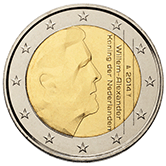
Dutch euro coins currently use two designs by Erwin Olaf, both of which feature a portrait of King Willem-Alexander of the Netherlands. The new designs began circulating in 2014. Dutch Euro coins minted from 1999 to 2013 feature a portrait of Queen Beatrix designed by Bruno Ninaber van Eyben. All coins share the 12 stars of the EU and the year of imprint in their design.

Guilder is the English translation of the Dutch and German gulden, originally shortened from Middle High German guldin pfenninc "gold penny". This was the term that became current in the southern and western parts of the Holy Roman Empire for the Fiorino d'oro. Hence, the name has often been interchangeable with florin.

The Surinamese dollar has been the currency of Suriname since 2004. It is divided into 100 cent. The Surinamese dollar is normally abbreviated with the dollar sign $, or alternatively Sr$ to distinguish it from other dollar-denominated currencies. In spoken Surinamese Dutch, it is widely referred to by its acronym SRD, with "dollar" generally being understood as meaning the US dollar.

The Belgian franc was the currency of the Kingdom of Belgium from 1832 until 2002 when the Euro was introduced. It was subdivided into 100 subunits, each known as a centiem in Dutch, centime in French or a Centime in German.

Victory Boogie Woogie is the last, unfinished work of the Dutch abstract painter Piet Mondrian, left incomplete when Mondrian died in New York in 1944. He was still working on it three days before dying. Since 1998 it has been in the collection of the Kunstmuseum, in The Hague. It has been said that "Mondrian's life and his affection for music are mirrored in the painting [and that it is] a testimony of the influence which New York had on Mondrian."
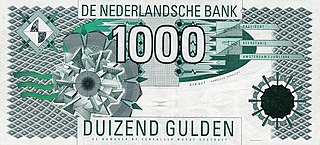
The guilder or florin was the currency of the Netherlands from 1434 until 2002, when it was replaced by the euro.
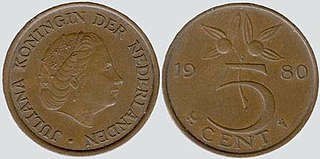
The stuiver was a coin used in the Netherlands, worth 1⁄20 Dutch Guilders. It was also minted on the Lower Rhine region and the Dutch colonies. The word can still refer to the 5 euro cent coin, which has almost exactly the same diameter and colour despite being over twice the value of the older coin.

The Netherlands Antillean guilder is the currency of Curaçao and Sint Maarten, which until 2010 formed the Netherlands Antilles along with Bonaire, Saba, and Sint Eustatius. It is subdivided into 100 cents. The guilder was replaced on 1 January 2011 on the islands of Bonaire, Saba and Sint Eustatius by the United States dollar.

The rijksdaalder was a Dutch coin first issued by the Republic of the Seven United Netherlands in the late 16th century during the Dutch Revolt which featured an armored half bust of William the Silent. It was the Dutch counterpart of the Reichsthaler of the Holy Roman Empire but weighed slightly less, at 29.03 g of 0.885 fine silver, reduced to 0.875 fine by the 17th century. Friesland, Gelderland, Holland, Kampen, Overijssel, Utrecht, West Friesland, Zeeland, and Zwolle minted armored half bust rijksdaalders until the end of the 17th century.
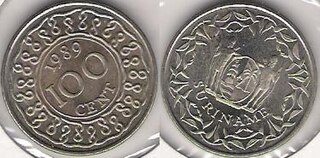
The guilder was the currency of Suriname until 2004, when it was replaced by the Surinamese dollar. It was divided into 100 cents. Until the 1940s, the plural in Dutch was cents, with centen appearing on some early paper money, but after the 1940s the Dutch plural became cent.

The Netherlands Indies guilder was the unit of account of the Dutch East Indies from 1602 under the United East India Company, following Dutch practice first adopted in the 15th century. A variety of Dutch, Spanish and Asian coins were in official and common usage. After the collapse of the VOC at the end of the 18th century, control of the islands reverted to the Dutch government, which issued silver 'Netherlands Indies' guilder and fractional silver and copper coins until Indonesian independence in 1945.
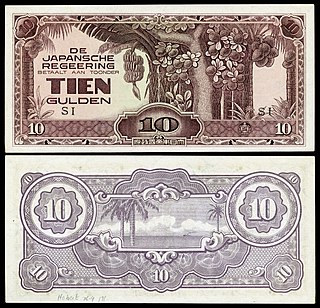
The Netherlands Indies guilder, later the Netherlands Indies roepiah, was the currency issued by the Japanese occupiers in the Dutch East Indies between 1942 and 1945. It was subdivided into 100 sen and replaced the guilder at par.

Chipknip was a stored-value payment card system used in the Netherlands. Based on the Belgian Proton system, it was started by Interpay on 26 October 1995, as a pilot project in the city of Arnhem and a year later rolled out countrywide. Chipknip was taken over by Currence due to a restructuring on 17 May 2005, who managed it with their licensees until its discontinuation on 1 January 2015. The Chipknip was primarily used for small retail transactions, as the card could contain a maximum value of 500 euros. The money needed to be transferred from a card holders main bank account using a loading station which were generally located next to ATMs.

The Dutch Five guilder coin was the highest-denomination coin in the Netherlands from its introduction in 1988 until the adoption of the euro in 2002. Its nominal value was ƒ 5,-.

The Battle in the Bay of Matanzas was a naval battle in Cuba during the Eighty Years' War in which a Dutch squadron was able to defeat and capture a Spanish treasure fleet.
This is a list of the central banks and currencies of the Caribbean.
The florin sign (ƒ) is a symbol that is used for the currencies named florin, also called guilder. The Dutch name for the currency is gulden. The symbol "ƒ" is the lowercase version of Ƒ of the Latin alphabet. In many serif typefaces, it can often be substituted with a normal italic small-letter f.

God zij met ons is a proverb phrase written on Dutch coins. This caption was formerly written on the edge of the guilder, rijksdaalder, five guilders, ten guilders and twenty-five guilders and today on 2-euro Dutch coins.
The Caribbean guilder is a planned currency of Curaçao and Sint Maarten, two constituent countries of the Kingdom of the Netherlands, officially slated for introduction in 2024. The Caribbean guilder is set to replace the Netherlands Antillean guilder (ANG) at par and be pegged to the U.S. dollar. The currency has an official launch scheduled for the second half of 2024; however, the launch has reportedly been pushed to 31 March 2025, pending confirmation from the ministry of finance. It is divided into 100 cents.
The Dutch Cancer Society is a Dutch Society committed to fight cancer by scientific research, education, patient support and fundraising in cooperation with volunteers, donors, patients, doctors and researchers. By this commitment, DCS targets less cancer, more cures and a higher quality of life for cancer patients. Its motto is, 'Everyone Deserves a Tomorrow' .

















